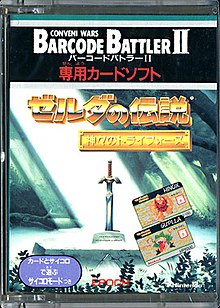
The Legend of Zelda is a high fantasy action-adventure video game franchise created by Japanese game designers Shigeru Miyamoto and Takashi Tezuka. It is primarily developed and published by Nintendo, although some portable installments and re-releases have been outsourced to Capcom, Vanpool, and Grezzo. The gameplay incorporates action-adventure and elements of action RPG games.
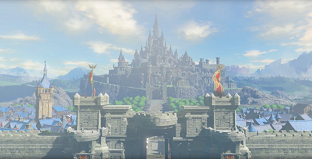
The Legend of Zelda is a video game franchise created by Japanese video game designers Shigeru Miyamoto and Takashi Tezuka. It is mainly developed and published by Nintendo. The universe of the Legend of Zelda series consists of a variety of lands, the most predominant being Hyrule. The franchise is set within a fantasy world that is reminiscent of medieval Europe and consists of several recurring locations, races and creatures. The most prominent population in the series are the Hylians, a humanoid race with elfin features, that are identifiable by their long, pointed ears. The game world is accompanied by a detailed fictional lore that contains a creation myth, several constructed languages, the most prominent being Hylian, and a fictional universal currency called the rupee. Most games in The Legend of Zelda series follow a similar storyline, which involves the protagonist Link battling monsters to save Princess Zelda and defeat an evil villain, which is often the series' main antagonist, Ganon. Nintendo developed the fictional lore into a complex timeline that spans across the series and chronicles thousands of years of fictional history.
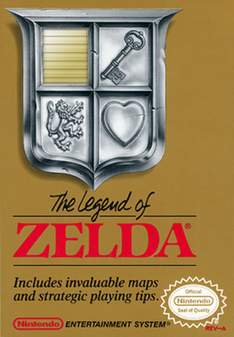
The Legend of Zelda, originally released in Japan as The Hyrule Fantasy: Zelda no Densetsu, is a 1986 action-adventure game developed and published by Nintendo. The first game of The Legend of Zelda series, it is set in the fantasy land of Hyrule and centers on an elf-like boy named Link, who aims to collect the eight fragments of the Triforce of Wisdom in order to rescue Princess Zelda from the antagonist Ganon. During the course of the game, the player controls Link from a top-down perspective and navigates throughout the overworld and dungeons, collecting weapons, defeating enemies and uncovering secrets along the way.

The Legend of Zelda: A Link to the Past is an action-adventure game developed and published by Nintendo for the Super Nintendo Entertainment System. It is the third game in The Legend of Zelda series and was released in 1991 in Japan and 1992 in North America and Europe.

The Legend of Zelda: The Wind Waker is a 2002 action-adventure game developed and published by Nintendo for the GameCube. An installment in The Legend of Zelda series, it was released in Japan in December 2002, in North America in March 2003, and in Europe in May 2003.

The Legend of Zelda: Oracle of Seasons and The Legend of Zelda: Oracle of Ages are two action-adventure games in the Legend of Zelda series, developed by Flagship. They were released in 2001 for Nintendo's Game Boy Color handheld console and re-released on the Virtual Console for the Nintendo 3DS in 2013. The games make up the seventh and eighth installment in the Zelda series.

Zelda II: The Adventure of Link is an action role-playing video game with platforming elements developed and published by Nintendo. It is the second installment in the Legend of Zelda series, and was released in Japan for the Famicom Disk System on January 14, 1987—less than one year after the Japanese release, and seven months before the North American release, of the original The Legend of Zelda. Zelda II was released in North America and the PAL region for the Nintendo Entertainment System in late 1988, almost two years after its initial release in Japan.

The Triforce is a fictional artifact and icon of Nintendo's The Legend of Zelda series of video games. It first appeared in the original 1986 action-adventure game The Legend of Zelda and is a focus of subsequent games in the series, including The Adventure of Link, A Link to the Past, Ocarina of Time, Oracle of Ages, Oracle of Seasons, The Wind Waker, Skyward Sword, and A Link Between Worlds. The Triforce consists of three equilateral triangles, which are joined to form a large equilateral triangle. In the lore of the series, it represents the essence of the Golden Goddesses who create the realm of Hyrule and is able to grant godlike power to the character who holds all three pieces. The Triforce also represents the three main characters of the series, Ganon, Zelda and Link, and their inherent qualities in the battle between good and evil. Due to its prominence and significance within the mythology of the Zelda series, the Triforce has received positive comments for being a widely recognisable symbol in gaming.
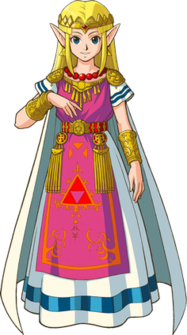
Princess Zelda is the titular character in Nintendo's The Legend of Zelda video game series. She was created by Shigeru Miyamoto and introduced in the original 1986 game The Legend of Zelda. She is one of the central characters in the series, having appeared in multiple incarnations over more than three decades. In the fictional storyline of the series, she is a princess of the kingdom of Hyrule, an associate of the protagonist Link, and bearer of the Triforce of Wisdom.
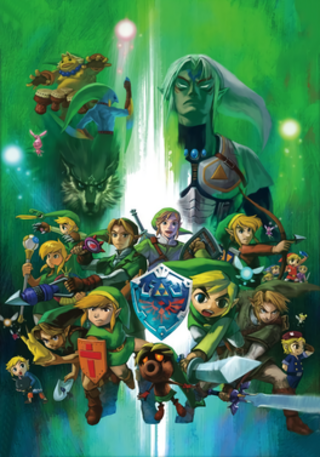
Link is the protagonist of Nintendo's video game franchise The Legend of Zelda. He was created by Japanese video game designer Shigeru Miyamoto. Link was introduced as the hero of the original 1986 The Legend of Zelda video game and has appeared in a total of 19 entries in the series, as well as a number of spin-offs. Common elements in the series include Link travelling through Hyrule whilst exploring dungeons, battling creatures and solving puzzles until he eventually defeats the series' primary antagonist, Ganon, and saves Princess Zelda.

Ganon is a fictional character and the primary antagonist of Nintendo's The Legend of Zelda video game series and franchise, as well as the final boss in many Zelda titles. A massive and malevolent creature, he first appeared in the original game, The Legend of Zelda (1986), and has since appeared in the majority of the games in the series. Ganon is the archenemy of the protagonist Link and the leader of the Gerudo, a race of humanoid desert nomads. In his Gerudo form, from which he can transmogrify, he is known as Ganondorf.

The Master Sword is a fictional divine magic sword in Nintendo's The Legend of Zelda series. It is also known as "The Blade of Evil's Bane", the "Sword of Resurrection", the "Sword that Seals the Darkness", and the "Sacred Sword". It was introduced in the 1991 action-adventure video game The Legend of Zelda: A Link to the Past and has since appeared in numerous other games in The Legend of Zelda series. The sword is the signature weapon of the hero, Link and has become an integral part of the character's visual identity and destiny in Zelda mythology. In the narrative of the Zelda series, it is a powerful, sacred weapon that Link repeatedly uses to defeat the main antagonist, Ganon and other forces of evil. Throughout the Zelda series, it is shown to have various magical powers, including the capability to repel evil, alter the flow of time and emit light beams to attack surrounding enemies. In addition to The Legend of Zelda series, the Master Sword has also appeared in various other video games, media and merchandise, including Super Smash Bros., Mario Kart 8 and Hyrule Warriors. It has been recreated in fan art, cosplay and weaponry and has become a widely recognisable image in video gaming.

The Barcode Battler is a handheld game console released by Epoch Co. in March 1991.
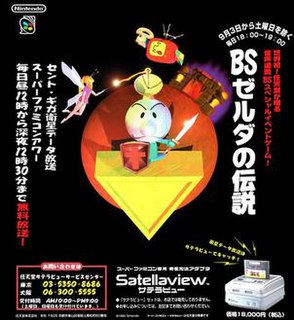
Between August 6, 1995 and May 30, 1999, Nintendo, in collaboration with St.GIGA, broadcast three different The Legend of Zelda titles to fans for download via the Super Famicom's Satellaview subsystem. BS Zelda no Densetsu, BS Zelda no Densetsu: MAP2, and BS Zelda no Densetsu: Inishie no Sekiban all featured SoundLink narration which was the first time that Nintendo-sponsored Zelda titles made use of voice-actors to provide vocal tracks. As the first SoundLink Game released via Satellaview, BS Zelda no Densetsu in particular was identified by Nintendo as the world's first integrated radio-game. Also broadcast during this time, starting on March 2, 1997, was a non-SoundLink port of The Legend of Zelda: A Link to the Past, known as Zelda no Densetsu: Kamigami no Triforce in Japan. Broadcasts of Kamigami no Triforce continued periodically throughout the tenure of Nintendo's partnership with St.GIGA, after which St.GIGA independently broadcast the game until May 29, 2000.

The Legend of Zelda: A Link Between Worlds is an action-adventure game developed and published by Nintendo for the Nintendo 3DS. The game is an installment in The Legend of Zelda series and a spiritual successor to the 1991 Super Nintendo Entertainment System game The Legend of Zelda: A Link to the Past. Officially announced in April 2013, A Link Between Worlds was released in Australia, Europe, and North America in November. A month later, it was released in Japan as The Legend of Zelda: Triforce of the Gods 2.

Hyrule Warriors is a hack and slash video game developed by Omega Force and Team Ninja for the Wii U video game console. The game is a collaboration between Koei Tecmo and Nintendo, mixing settings and characters from Nintendo's The Legend of Zelda with the gameplay of Koei's Dynasty Warriors series. Hyrule Warriors was released in Japan in August 2014, and worldwide the following month. It became one of the best-selling games on the Wii U. An updated port, Hyrule Warriors Legends, was released for the Nintendo 3DS in Japan in January 2016 and worldwide in March of the same year. A second enhanced port, Hyrule Warriors: Definitive Edition, was released for the Nintendo Switch in 2018. A successor, Hyrule Warriors: Age of Calamity, was released exclusively for the Nintendo Switch in November 2020.

"It's dangerous to go alone! Take this." is a quotation from the 1986 video game The Legend of Zelda for the Nintendo Entertainment System (NES). It is spoken by an unnamed old man, met in the cave at the start of the game, who gives the player-character Link a sword to aid his quest to defeat Ganon and rescue Princess Zelda. The quote has been referenced in video gaming and other media, has become an Internet meme, and has been established in pop culture.

The Legend of Zelda is a high-fantasy video game series created by Japanese game designers Shigeru Miyamoto and Takashi Tezuka. It is primarily developed and published by Nintendo, although some portable installments have been outsourced to Capcom, Vanpool and Grezzo. The series' gameplay incorporates elements of action, adventure and puzzle-solving games.


